| FONAR has been
designing and manufacturing receiver coils in-house since
its inception in 1978, and has remained a leader in receiver
coil design ever since. FONAR has several in-house teams of
high-level scientists and engineers devoted to improving existing
receiver coil designs and introducing new ones. |
Solenoid
Receiver Coils
FONAR’s first receiver coils, or surface coils,
were solenoid receiver coils. These coils are basically wrapped
around the region of interest. The solenoid receiver coil
has been and continues to be a perfect match for FONAR scanners.
It is a fundamental fact of physics that optimal Signal-to-Noise
Ratios (SNR) are achieved when the axis of the receiver coil
is perpendicular to the direction of the scanner’s magnetic
field. Such is the case with every FONAR MRI ever made, including
the Stand-Up MRI.
For example, with the patient lying down with a solenoid
coil around his waist, the axis of the solenoid coil runs
along the length of the body. In combination with either a
vertical or a horizontal magnetic field (as is the case with
the Upright™ MRI), the coil axis is perpendicular to
the direction of the magnetic field. Note that in the case
of the Stand-Up MRI, this optimal right-angle relationship
is preserved whether the patient is standing, sitting bending
or lying down.
With superconductive MRI scanners, the horizontal magnetic
field would be parallel, rather than perpendicular, to the
solenoid coil axis. Therefore these scanners cannot capitalize
on the SNR advantage of the solenoid design are forced to
use less efficient receiver coil designs instead.
While continuing to improve and expand its solenoid receiver
coil package, FONAR has also successfully developed other
types of highly efficient receiver coils.
<click picture for larger view> |
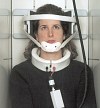 |
Cervical
Solenoid Coil
FONAR’S flexible Cervical Solenoid Coil optimizes
imaging of the cervical spine. In the photo, the patient’s
head was immobilized for a cervical spine study in the neutral
position. The coil is also ideally suited for Position Imaging™
(pMRI™) applications of the cervical spine, including
flexion, extension, rotation, and lateral bending.
|
 |
Expanded
Diameter Solenoid Cervical Coil
The Expanded Diameter Solenoid Cervical Coil is for
patients that require a more loosely fitting coil in order
to flex, extend or bend their necks as far as they are able
to. pMRI™ applications give the referring physician
the most complete picture of the patient’s condition.
|
 |
High-performance
Spine and Body Coil Set (45-inch, 55-inch and 65-inch
circumferences)
These flexible wraparound coils provide uniform posterior-to-anterior
signal intensity and extended longitudinal coverage for spine
and body imaging. The user can choose the optimal patient
filling-factor to increase SNR.
|
 |
Signal
Plus™ Open Head Coil
The Signal Plus™ Open Head Coil employs an advanced
multi-conductor design that provides the high Signal-to-Noise
Ratios necessary for neuroimaging applications.
|
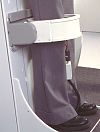 |
Signal
Plus™ Knee
This circular multi-conductor receiver coil for knee
imaging can also be used for the thigh, calf and ankle.
|
 |
Wrist
Coil
The FONAR wrist coil is a rigid, multi-conductor receiver
coil optimized for high-resolution wrist or small extremity
imaging.
|
Planar
Coils
The unique transaxial horizontal magnetic field of the Upright™
MRI makes it the ONLY Open MRI system that can use flat planar
coils. The advantage of planar coils is that they can be placed
close to the targeted anatomy, which results in high Signal-to-Noise
Ratios (SNR) and, therefore, excellent images. |
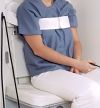 |
Planar
T-L (Thoracic-Lumbar) Coil
The Planar Thoracic-Lumbar Coil is placed directly
behind the patient’s back. The patient leans against
the coil and sits comfortably throughout the scan.
|
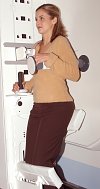 |
Shoulder Coil - Seated
FONAR’s shoulder coil employs a unique double-planar
design. The coil, which can be used on either shoulder, interfaces
with an immobilization fixture that attaches to the patient
bed.
|
Quadrature
Coils
The quadrature coil combines two coils, called a quadrature
pair, configured to operate in concert to achieve higher SNR
than can be obtained with a single receiver coil. |
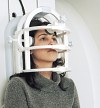 |
Quadrature
Head Coil
The Quadrature Head Coil provides excellent neuroimaging
capabilities. It can be used with the patient in either an
upright or recumbent posture. Adjustable movement inhibitors
keep the patient’s head immobilized throughout the scan.
The large spaces between the coil conductors allow the patient
an unobstructed view of a TV mounted on the scanner room wall.
|
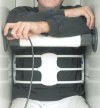 |
Quadrature
T-L (Thoracic-Lumbar) Coil
Because of its unique magnet configuration, the Upright™
MRI is the ONLY MRI scanner that is able to utilize a solenoid
(wrap-around) coil and a flat planar coil as its quadrature
pair. Each coil in FONAR’s quadrature pair offers its
own special advantage: The solenoid coil is remarkably SNR-efficient
– more so than saddle-shaped coils used with conventional
superconductive MRI scanners; and the companion planar coil
achieves remarkable SNR because of its close proximity to the
targeted anatomy. The combination of the two makes the Quadrature
Thoracic-Lumbar Coil an extraordinary performer. |

|
VersaRest™
Fixture
The VersaRest™ fixture provides the patient with
something sturdy to lean on during the scan, making the patient
comfortable and reducing body motion. For example, for flexion
studies of the lumbar spine, patients bend forward at the
hip and comfortably rest their forearms on the VersaRest™
fixture. The VersaRest™ fixture can be placed anywhere
in the patient gap, and is easily installed or removed in
a few seconds.
|
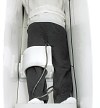 |
Quadrature
Knee Coil
The Upright™ MRI is the ONLY MRI scanner capable
of performing weight-bearing extremity studies. Weight-bearing
knee scans can be done with the patient standing or with the
bed tilted back to any selected angle. With the bed tilted
back, the patient is usually more comfortable and is better
able to remain still throughout the procedure. The coil attaches
directly to the bed. Patient positioning is quick and easy.
|
